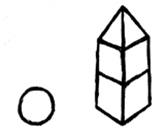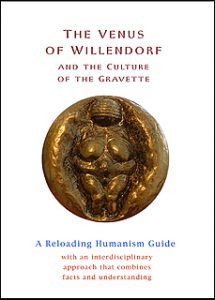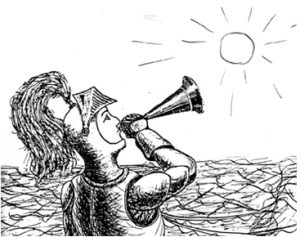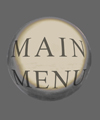
Consisting of both letters and hieroglyphs, in Humanese, the sign:
![]()
is the letter „umeter“ which is associated with life and the life principle that infuses all living things. Humanese features 23 letters and an accent or aspiration, that as in Ancient Greek, imparts an „h“ sound to any vowel that it is combined with. This is the sign:
![]()
which combined with „umeter“:
![]()
reads as „hu“ and stands for the breath, not of life but of conscious apprehension and intelligence. Though the possession of hu is not an attribute that is exclusive to human beings, no other creature has as much hu as a human being does. With hu there is the capacity for humour and in animals, evidence of humour has been detected in elephants and dolphins. Along with honesty and humility, we must re-learn that humour is a much-needed counter against the temptations of vanity to which we so readily succumb as well as the dogma and narrow-mindedness that characterise intolerance.
Deriving from umeter is „manna“:
![]() This conveys the sound „m“ and in its uppercase form is also a hieroglyph for „manna“, the food that in the Bible, fell from the sky and sustained the people of Israel during their forty years of wandering in the desert. Thus in its uppercase form it resembling two loaves of bread whilst in in its lowercase form it recalls a bird in flight. The hieroglyph hints at the lofty heights that, through perseverance, things endowed with life and fed with manna, may attain. The hieroglyph:
This conveys the sound „m“ and in its uppercase form is also a hieroglyph for „manna“, the food that in the Bible, fell from the sky and sustained the people of Israel during their forty years of wandering in the desert. Thus in its uppercase form it resembling two loaves of bread whilst in in its lowercase form it recalls a bird in flight. The hieroglyph hints at the lofty heights that, through perseverance, things endowed with life and fed with manna, may attain. The hieroglyph:
![]()
denotes „ayen“, this being the third person plural of a semi-verb that imparts the concept of „would“ to an infinitive, noun or phrase, as in „they would do such and such“. This can either be a condition of being, a general disposition or, or can refer to a group of people’s doing such and such if they had the means and where withal. Combined with „manna“, on a literal level „ayen“ denotes „they who would (have) manna“:
![]()
Yet as seen „manna“ also hints at a yearning for greater things and the hieroglyph and so represents humanity and the disposition of our species to achieve great things and attain great heights if we but have the manna and where withal at our disposal.
Resembling a figure with open arms, the hieroglyph „osmache“:

represents the concept of welcoming. Meanwhile the sign:
![]()
is the letter „ana“ which standing alone is a preposition that corresponds to „to“, „towards“ and „in the direction of“. The hieroglyph:
![]()
is the verb reinkarne which means to revive, reanimate, recharge or reload something. Thus the message:

reads as: osmache ana reninkarne humanna ayen and translates as „welcome to they who would reload humanism“.
From a biological point of view, the phenomenon of life is a result of the fact that the nuculoid acids are capable of doubling-up and of performing not one function but two. This enables them to carry out specific tasks such as manufacturing a protein or checking whether a protein has been properly manufactured and in addition, to replicate themselves. In this way they can execute specific functions and grow. Without this ability, life as we know it would never have come to be. In Humanese, hieroglyphs can likewise be made to double-up and from the signs, two-dimensional shapes may be formed, which folded around onto themselves in three dimensions, result in spatially defined forms. Some of these, such as the hieroglyph „akinemene“:
![]()
which stands for “beginning, end, definition and enclosure”, are self contained as from the cross shape, a cube made be readily formed:

Taking the phrase, „an’akine akenemenos pleis“:
![]()
and from „ana“ making a sphere, from the two swords or cross shapes of „akine akinemenos“, making two cubes and from „pleis“, making a pyramid, results in a tower with a sphere rolling towards it.

Others however are incomplete and need to be added to another in order for a three-dimensional object with a closed surface to be brought into being. In Humanese, the meanings of signs are supported and underlined by the forms of the three-dimensional objects that can be made from them. In the case of:

if from the letters and hieroglyphs, shapes are formed:
 and these are then folded around onto themselves to result in four, three-dimensional forms which when combined to make a whole, whose form underlies the ethos inherent in the signs.
and these are then folded around onto themselves to result in four, three-dimensional forms which when combined to make a whole, whose form underlies the ethos inherent in the signs.

This is world famous Venus of Willendorf. Displayed in Room 11 of the Natural History Museum in Vienna and is an outstanding example of the female statuettes which typify what archaeologists call „Gravettian culture“. Originally the Venus of Willendorf was painted with red orchre. The colour of blood, this stood for life and survival. Thus at Reloading Humanism, the figurine is taken as an emblem for our precarious and oh-so fragile future.

The shapes are given at the end of the book, The Venus of Willendorf and the Culture of the Gravette, whih can be previewed by going to Reloading Humanism Books & Music page where there are links for online ordering. Assembly instructions accompany the shapes with a step by step photographic guide can be accessed via the Reloading humanism Mission page: A Message from Willendorf.
The point of a series of shapes that not only bears a message but which can also be made into an object, is that while life may well be, as Shakespeare puts it but „a poor player that struts and frets his hour upon the stage“ (Macbeth, Act V, scene 5, line 25-26), on a lower level (not perceived by the fraught player besought with cares), life is a pun and a joke. Like the shapes of the Venus of Willendorf paper model, which both define form and serve as hieroglyphs, as already observed, the nucleic acids on which life is built are capability of „doubling up“ and taking on two different roles. Yet this is not all and as first realised by Emil Fischer, not only do the nucleic acids in the bodies of all living things double-up, each and every molecule in each and every living cell, is tailored by evolution to fit in, like a key in a lock, with all the other chemical processes going on within the cell. Not infrequently, different processes compete with each other for the same raw materials and chaos theory now explains how from out of this competition, the rhythms of life can be seen as coming into being. Humanese is thus a Kabbala of shapes and forms and enables one to arrive at an image that looks both back towards our past and forward into a future for which we must selflessly and unrelentingly fight if it is to be secured. In the paper model of the Venus of Willendorf, the hieroglyph for hu forms the head whilst the hieroglyph for “manna” forms the lower part of the body and legs. Meanwhile the hieroglyphs that denote welcoming and regeneration form the middle part of the figure – where anatomically the heart is. The message is that it is up to us, with our hearts, to underwrite and give meaning to, not only the signs of Humanese but to all things in the world around us. For without people who care about things there can be no welcome, no regeneration and no future.
As the age of age of migration slowly drew to an end in around the tenth century AD, people lived in settlements in which defensive structures were built as places of refuge in times of attack. As a new feature, towers were built so that potential attackers could be identified from far away. If an unknown band of people were seen, the lookout manning the tower would sound the alarm by blowing a horn. Taking a cue from this and the exhortation „an’akine akinemenos pleis“ it is time to accept our role as watchmen for the health of our planet and blow the horn or „orsana“ that sounds the alarm.

While this is not Punk Rock, it rocks the boat by going beyond anger. Supported by philosophy, mathematics and biology (see the One World Pragmatism essay on the Mission Page), it gives a complete and holistic vision of something that if we are to have a future, quite simply must be. Nothing more, nothing less. Welcome to all those who would reload humanism.

